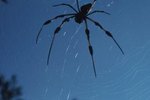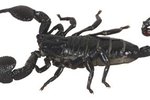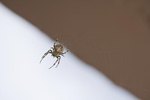
Also known as camel spiders or wind scorpions, sun spiders are neither spiders nor scorpions. Instead, sun spiders are a different type of arachnid entirely -- scientists call them solpugids. While they share some characteristics with spiders and scorpions, they have a number of key differences -- sun spiders are eight-legged predators like their arachnid kin, but scientists do not think they have venom glands.
Solpugid Basics
Sun spiders -- named such because they inhabit sunny habitats -- live in deserts and semi-arid areas. Approximately 900 sun spider species inhabit Asia, Africa and the Americas; more than 50 of these species inhabit the American southwest. Arizona sun spiders are approximately 1 to 3 inches long, and yellow to tan in color.
Giant Chelicerae
Sometimes reddish in color for Arizona specimens, sun spiders have very thick chelicerae on the front of their heads. They use the large pincers at the end of the chelicerae to capture and subdue prey. So far, scientists have been unable to find venom glands in or near the sun spiders’ enormous chelicerae, and they suspect that spiders are not venomous, despite their impressive and intimidating pincers on the front of their heads.
Speedy Sun Spiders
Sun spiders use their long legs to run incredibly fast -- and run faster than most other invertebrates can. Scientists estimate that they are capable of attaining 10 mph in ideal circumstances. This speed helps sun spiders to capture their prey, which includes insects, spiders, scorpions and the occasional gecko. Additionally, some sun spider species live in or near, and predate on, termite colonies.
Sensory Organs
Behind the pincers and chelicerae of sun spiders, lay a pair of pedipalps. Pedipalps are important organs that serve both tactile and olfactory functions. When running, sun spiders often hold their pedipalps high off the ground. Sun spiders are also covered in short, bristle-like hairs that detect and transmit other stimuli.
Sun Spider Behavior
Most sun spiders are nocturnal; they spend the days hiding from the hot sun in their relatively cool burrows. They may dig 40 or more burrows in their lifetime; however, they lack significant physical adaptations for digging. Sun spiders respond to predators with aggressive displays, brandishing their pincers, biting or using their speed to escape.
Sun Spider Reproduction
When preparing to breed, male and female sun spiders engage in a mating "dance." Male sun spiders then flip the females onto their backs -- the males use their chelicerae to insert sperm into the females receptacles -- termed gonophores. After a lengthy gestation, the female digs a burrow in which she deposits as many as 200 eggs. Differing from scorpions and some other arachnids, which provide some parental care, most sun spider species provide no parental care.
References
- Arizona Cooperative Extension: Scorpion-Like Creatures
- Arizona-Sonora Desert Museum: Tailless Whipscorpions & Sun Spiders
- National Geographic: Egyptian Giant Solpugids
- Psyche: Burrowing Habits of North American Solpugida (Arachnida)
- The Florida Entomologist: Feeding Behavior of North American Solpugida (Arachnida)
- Backyard Gardener: The Fierce Solpugid - May 1, 2002
- Animal Diversity Web: Arachnida
Photo Credits
-
Jupiterimages/Photos.com/Getty Images




